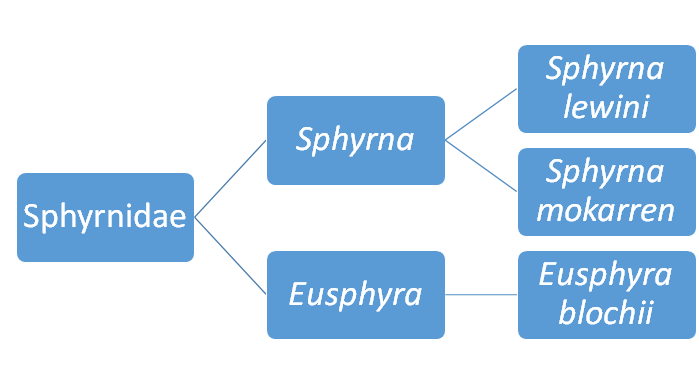Classification
Domain: Eukarya
Kingdom: Animalia
Phylum: Chordata
Class: Chondrichthyes
Order: Carcharhiniformes
Family: Sphyrnidae
Genus: Sphyrna
Species: Sphyrna lewini
Eukarya: Any organism whose cells contain a nucleus belongs to the Eukarya domain.
Animalia: Just like it sounds, this is the animal kingdom. It is pretty obvious that this shark is an animal and not some sort of plant, fungus, etc.
Chordata: The chordates include us humans and the vertebrates. Chordates are all deuterostomes, meaning that when developing, their anus forms first as opposed to the mouth forming first.
Chondrichthyes: Members of this class are characterized simply as cartilaginous fish (EOL, 2009). Cartilaginous means that their skeletons are made out of cartilage instead of bone. The majority of the chondrichthyes order is made up of sharks. (EOL, 2009).
Carcharhniformes: As stated above, most chonodrichthyes are sharks. Getting down into the order classicfication, the type of shark starts to get more specific. Carcharniformes consists of the ground sharks (EOL, 2009). Considering the fact that Sphryna lewini live in very shallow waters where the ground is never too deep, this makes a lot of sense.
Sphyrnidae: Getting more and more specific, members of the sphyrnidae family consist of hammerhead, bonnethead and scoophead sharks (Myers et al. 2013). Given that our organism is the scalloped hammerhead shark, I'm sure you can see where it fits into this family.
Sphyrna: As you probably could've guessed, the genus sphyrna simply kicks out the other two groups of the sphyrnidae family so that only hammerhead sharks remain (Myers et al. 2013).
Sphyrna lewini: Finally down to the species level. As you know, the specific hammerhead we are covering is the Sphyrna lewini or in english the scalloped hammerhead shark.

Figure 1. Phylogenetic tree representing the phylum, class and order of the Sphyrna leweni as well as some close relatives. Figure based on morphological differences.
This tree starts at the phylum classification. As stated in above information this is the phylum in which the Sphyrna lewini belong. Next the tree breaks off into two classes. Chondrichthyes and cladoselachimorpha. You may notice that the class cladoselachiformes is not in line with all of the classes derived from chondrichthyes. This is because order cladoselachiformes has gone extint (EOL, 2009). Further to the right you can see all of the closest to order carharhiniformes. Once again, all of these relatives are cartilaginous fish.

Figure 2. A phylogenetic tree representing the family, genus and species of the Sphyrna lewini as well as some close relatives at the genus and species level. Figure based on morphological differences.
From family sphyrnidae which as stated above consists of just a few types of sharks, we split into genus Sphyrna and genus Eusphyra. Members of genus Eusphyra are also hammerhead sharks, however they are much smaller and have slight differences in the "hammer" form. Sphyrna lewiini and Sphyrna mokarren at the species level are obviously both members of the Sphyrna genus. The difference between the two is that the Sphyrna mokarren is the "Great Hammerhead" and is much larger and the "hammers" of the two species differ (Myers et al. 2013).